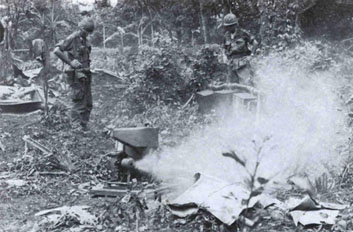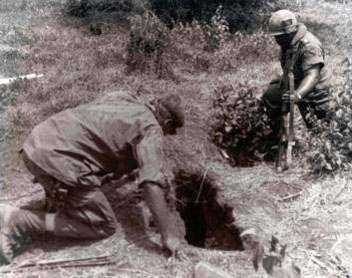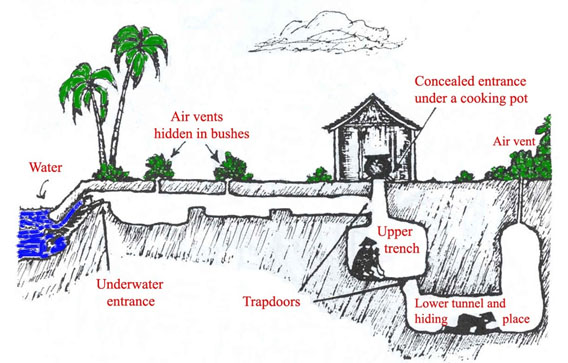To counter the immense technological advantage held by U.S. and allied forces during the Vietnam Conflict, the Viet Cong developed an extensive network of underground tunnel complexes. From these tunnels, which were concentrated mostly around Cu Chi but spread as far as the outskirts of Saigon, the enemy could effectively ambush American forces and then safely vanish underfoot. The tunnels became so highly developed that they eventually contained armories, hospitals, mess halls, manufacturing centers, and storage facilities. Some complexes ranged up to 40 miles long; the Cu Chi tunnel complex contained 130 miles of passageways.
Having begun construction during their fight for independence against the French, the Vietnamese had incorporated a number of unique, battle-tested design features in their tunnels. They were made with minimal breadths with angled walls and were virtually impassable by most Westerners. Detection was difficult; airshafts were camouflaged and entryways disguised by filled wells dropping 50 feet. There were a variety of tunnel types: squad-size tunnels generally were less than 6-feet deep and 100-feet long; company-size tunnels were wider but not extensively compartmented; and battalion-size tunnels could burrow 50 feet underground and sometimes contain up to four different levels. Extensive booby-trapping made it nearly impossible for American troops to extricate the enemy from their impregnable safe-havens that allowed them to withstand intense aerial bombardment—even by crater-making B-52 bombs.
 |
|
 |
| |
|
|
| Engineers unpack and test a Mitey-Mite blower in the Vietnamese jungle |
|
A soldier from the 8th Engineer Battalion, 1st Cavalry Division, prepares to enter a tunnel while an armed soldier keeps guard |
While Army engineers faced a daunting task in destroying these systems, they nevertheless had developed a number of methods for doing so. The least effective was by mechanical means, as bulldozers and plows could not displace any but the shallowest of tunnels and only with great difficulty could they be deployed in densely vegetated and remote areas. Flooding also proved ineffective because the Viet Cong had dug additional wells deep inside to prevent the tunnel complexes from becoming saturated. An even less desirable but most immediately available method was for volunteers from special engineer tunnel demolition teams (who became known as “tunnel rats”) to enter headfirst into the tunnels to clear them out the hard way.
Other means could avoid such insertion. Conventional explosives were tried. Block explosives placed at critical points with a force of 2-pounds-per-foot could bring down a section, although they generally would not affect other parts of the bunkers. Shaped charges facing upward also could destroy specific tunnel segments. Also, it was found through trial and error that ring mains with delay caps allowed lower charges to detonate first, which would bring down entire tunnels. Another way was to deposit cratering charges in five-foot-deep holes along the outside trace of a known tunnel. Because of their explosive characteristics, Bangalore torpedoes were the most successful conventional means in effecting complete destruction. But because of their 5-foot lengths, each Bangalore section had to be carried into the tunnels and emplaced by hand. Overall, however, the large quantity required and the need for soldiers to physically place the charges limited the use of most conventional explosives.
Different and more innovative methods were employed, such as running tubing along the length of a tunnel and filling it with liquid explosive, either by gravity fill or a pumping system, although the highly flammable nature of these liquid explosives often countered their effective use. Another means of denying use of the tunnels was through the introduction of CS powder, smoke, or riot-control agents aerosolized and dispersed by the Mitey Mite Blower. It was believed that some of these chemical agents would remain on the tunnel walls and render them uninhabitable for months. But the dense jungle and poor climatic conditions often “swallowed up” chemical dispersants.
Most effectively, engineers used acetylene for destruction of tunnels with less than 7 feet of over-burden. A charge could ignite an acetylene-air gaseous mixture generated from a calcium carbide and water reaction. Four cubic yards of acetylene pumped into an area could destroy more than 50 cubic yards of tunnel volume. When acetylene was used in conjunction with conventional explosives, the effect could collapse 15 feet of overburden. But this latter method also involved inherent danger due to volatility of the chemical compounds.
In the end, enemy operations from the tunnels were never completely eradicated in spite of the ingenuity of Army engineers. The tunnels around Cu Chi are now a major tourist attraction—having been widened to accommodate Westerners.

Diagram depicting the many possible entrances and levels found in Viet Cong tunnels
Image sources:
The Army Engineer in Vietnam, The U.S. Army Engineer School, Fort Belvoir, VA. (Not dated.)
Report on the Employment of Acetylene in the Destruction of Viet Cong Tunnels. (Not dated.)
* * *
January 2003